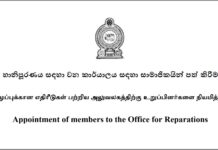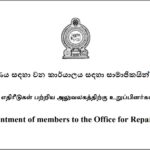Compiled By: Gp Capt Kumar Kirinde, SLAF (Retd)
[A great service established for global shipping in late 1800s which became a centre for regional armed conflict in mid 1900s]
Introduction
The Suez Canal is an artificial sea-level waterway in Egypt, connecting the Mediterranean Sea to the Red Sea through the Isthmus of Suez and dividing Africa and Asia.
It offers vessels a direct route between the North Atlantic and northern Indian oceans via the Mediterranean Sea and the Red Sea, avoiding the South Atlantic and southern Indian oceans and reducing the journey distance from the Arabian Sea to London by approximately 8,200 kilometres (5,100 mi or 4,432 nms).
The canal extends from the northern terminus of Port Said to the southern terminus of Port Tewfik at the city of Suez. Its length is 193.30 km (120.11 mi) including its northern and southern access-channels. In 2020, more than 18,500 vessels traversed the canal (an average of 51.5 per day).
In 1858, Ferdinand de Lesseps formed the Suez Canal Company for the express purpose of building the canal. Construction of the canal lasted from 1859 to 1869 and took place under the regional authority of the Ottoman Empire. The canal officially opened on 17 November 1869.
While the canal was the property of the Egyptian government, European shareholders, mostly British and French, owned the concessionary company which operated it until July 1956, when President Gamal Abdel Nasser nationalized it—an event which led to the Suez Crisis of October–November 1956. The canal is operated and maintained by the state-owned Suez Canal Authority (SCA) of Egypt. Under the Convention of Constantinople, it may be used “in time of war as in time of peace, by every vessel of commerce or of war, without distinction of flag.” Nevertheless, the canal has played an important military strategic role as a naval short-cut and choke point. Navies with coastlines and bases on both the Mediterranean Sea and the Red Sea (Egypt and Israel) have a particular interest in the Suez Canal. After Egypt closed the Suez Canal at the beginning of the Six-Day War on 5 June 1967, the canal remained closed for precisely eight years, reopening on 5 June 1975.
The Egyptian government launched construction in 2014 to expand and widen the Ballah Bypass for 35 km (22 mi) to speed up the canal’s transit-time. The expansion intended to nearly double the capacity of the Suez Canal, from 49 to 97 ships per day. At a cost of 59.4 billion Egyptian pounds (US$9bn), this project was funded with interest-bearing investment certificates issued exclusively to Egyptian entities and individuals. The “New Suez Canal”, as the expansion was dubbed, was opened in a ceremony on 6 August 2015.
The Suez Canal Authority officially opened the new side channel in 2016. This side channel, located at the northern side of the east extension of the Suez Canal, serves the East Terminal for berthing and unberthing vessels from the terminal. As the East Container Terminal is located on the Canal itself, before the construction of the new side channel it was not possible to berth or unberth vessels at the terminal while a convoy was running.
Development of concept for the canal
During the French campaign in Egypt and Syria in late 1798, Napoleon expressed interest in finding the remnants of an ancient waterway passage. This culminated in a cadre of archaeologists, scientists, cartographers and engineers scouring northern Egypt. Their findings, recorded in the Description de l’Égypte, include detailed maps that depict the discovery of an ancient canal extending northward from the Red Sea and then westward toward the Nile.
Later, Napoleon, who became the French Emperor in 1804, contemplated the construction of a north–south canal to connect the Mediterranean with the Red Sea. But the plan was abandoned because it incorrectly concluded that the waterway would require locks to operate, the construction of which would be costly and time-consuming. The belief in the need for locks was based on the erroneous assumption that the Red Sea was 8.5 m (28 ft) higher than the Mediterranean. This estimate was the result of using fragmentary survey measurements taken in wartime during Napoleon’s Egyptian Expedition.
Despite the construction challenges that could have been the result of the alleged difference in sea levels, the idea of finding a shorter route to the east remained alive. In 1830, General Francis Chesney submitted a report to the British government that stated that there was no difference in elevation and that the Suez Canal was feasible, but his report received no further attention.
Preporations for the construction of the canal (1854-1858)
Convening the International Commission for the piercing of the Isthmus of Suez
In 1854 and 1856, Mohamed Sa’id Pasha, a French diplomat and entrepreneur obtained a concession from Mohamed Sa’id Pasha, the Wali of Egypt and Sudan (officially owing fealty to the Ottoman Sultan but in practice exercising virtual independence), to create a company to construct a canal open to ships of all nations. The company was to operate the canal for 99 years from its opening. De Lesseps had used his friendly relationship with Sa’id, which he had developed while he was a French diplomat in the 1830s.
As stipulated in the concessions, de Lesseps convened the International Commission for the piercing of the Isthmus of Suez consisting of 13 experts from seven countries to examine the plans developed by Linant de Bellefonds, an explorer of Egypt and the chief engineer of Egypt’s public works, and to advice on the feasibility of and the best route for the canal. After surveys and analyses in Egypt and discussions in Paris on various aspects of the canal, the commission produced a unanimous report in December 1856 containing a detailed description of the canal complete with plans and profiles.
Opposition from the British
The British government had opposed the project from the outset to its completion. The British, who controlled both the Cape route and the Overland route to India and the Far East, favored the status quo, given that a canal might disrupt their commercial and maritime supremacy.
Establishing the Suez Canal Company
The Suez Canal Company came into being on 15 December 1858. Initially international opinion was skeptical and Suez Canal Company shares did not sell well overseas. Britain, Austria, and Russia did not buy a significant number of shares. However, with assistance from the Cattaui banking family, and their relationship with James de Rothschild of the French House of Rothschild bonds and shares were successfully promoted in France and other parts of Europe. All French shares were quickly sold in France.
Construction of the canal (1859–1869)
Work started with construction on the shore of the future Port Said on 25 April 1859. Then excavation to construct the canal commenced which took some 10 years to complete. Forced labour were employed until 1864 to dig out the canal. Some sources estimate that over 30,000 people were working on the canal at any given period, that more than 1.5 million people from various countries were employed, and that tens of thousands of labourers died, many of them from cholera and similar epidemics.
Deaths of workers who were engaged in canal construction work
Estimates of the number of deaths of construction workers vary widely with Egyptian President Gamal Abdel Nasser famously citing 120,000 deaths in a 26 July 1956 speech and the company’s chief medical officer reporting no higher than 2.49 deaths per thousand in 1866. Doubling these estimates with a generous assumption of 50,000 working staff per year over 11 years would put a conservative estimate at fewer than 3,000 deaths. More closely relying on the limited reported data of the time, the number would be fewer than 1,000.
Growth and reorganisation with United Kingdom acquiring 44% of shares of the Suez Canal Company
The canal had an immediate and dramatic effect on world trade. Combined with the American transcontinental railroad completed six months earlier, it allowed the world to be circled in record time. It played an important role in increasing European colonization of Africa. The construction of the canal was one of the reasons for the Panic of 1873 in Great Britain, because goods from the Far East had, until then, been carried in sailing vessels around the Cape of Good Hope and stored in British warehouses.
Them an inability to pay his bank debts led Said Pasha’s successor, Isma’il Pasha, in 1875 to sell his 44% share in the canal for £4,000,000 ($19.2 million), equivalent to £432 million to £456 million ($540 million to $570 million) in 2019, to the government of the United Kingdom. But French shareholders still held the majority. Local unrest caused the British to invade in 1882 and take full control, although nominally Egypt remained part of the Ottoman Empire. The British representative in Egypt (1883 to 1907) was Evelyn Baring, 1st Earl of Cromer, who reorganized and modernized the government in his capacity as the Controller-General of Egypt and suppressed rebellions and corruption, thereby facilitating increased traffic on the canal.
Main beneficiaries and key developments upto 1956
The European Mediterranean countries in particular benefited economically from the Suez Canal, as they now had much faster connections to Asia and East Africa than the North and West European maritime trading nations such as Great Britain, the Netherlands or Germany. The biggest beneficiary in the Mediterranean was Austria-Hungary, which had participated in the planning and construction of the canal.
In 1879 at the request of Khedive Tewfiq, the Egyptian leader, The British assisted to suppress the Urabi Revolt against his rule. The revolt went till 1882. The Convention of Constantinople in 1888 declared the canal a neutral zone under the protection of the British, who had occupied Egypt and Sudan, with the condition that it may be used “in time of war as in time of peace, by every vessel of commerce or of war, without distinction of flag.”
During the First World War (1914-1918), the British defended the Suez Canal, a strategically important passage, against a major Ottoman attack in 1915. Under the Anglo-Egyptian Treaty of 1936, the UK retained control over the canal which was again strategically important during the Second World War (1939–1945). The Italian-German attempts to capture the canal were repulsed during the North Africa Campaign, during which the canal was closed to Axis shipping. In 1951 Egypt repudiated the Anglo-Egyptian Treaty and in October 1954 the UK agreed to remove its troops and which was done and completed by 18 July 1956.
Inauguration of the canal (17 November 1869)
The canal opened under French control in November 1869. The opening ceremonies began at Port Said on the evening of 15 November, with illuminations, fireworks, and a banquet in the yacht of the Khedive Isma’il Pasha of Egypt and Sudan. The royal guests arrived the following morning: the Emperor Franz Joseph I, the French Empress Eugenie in the Imperial yacht L’Aigle, the Crown Prince of Prussia, and Prince Louis of Hesse. In the afternoon there were blessings of the canal with both Muslim and Christian ceremonies, a temporary mosque and church having been built side by side on the beach. In the evening there were more illuminations and fireworks.
On the morning of 17 November, a procession of ships entered the canal, headed by the L’Aigle. Among the ships following was HMS Newport, captained by George Nares, which surveyed the canal on behalf of the Admiralty a few months later.
Ismailia was the scene of more celebrations the following day, including a military “march past”, illuminations and fireworks, and a ball at the Governor’s Palace. The convoy set off again on the morning of 19 November, for the remainder of the trip to Suez. After Suez, many of the participants headed for Cairo, and then to the Pyramids, where a new road had been built for the occasion.
An Anchor Line ship, the S.S. Dido, became the first to pass through the Canal from South to North.
Note: Part 2 of this compilation will also be on thesundayreader.lk next Sunday ( 27th Sep 2021)
Courtesy: Source: https://en.wikipedia.org/wiki/Suez_Canal












